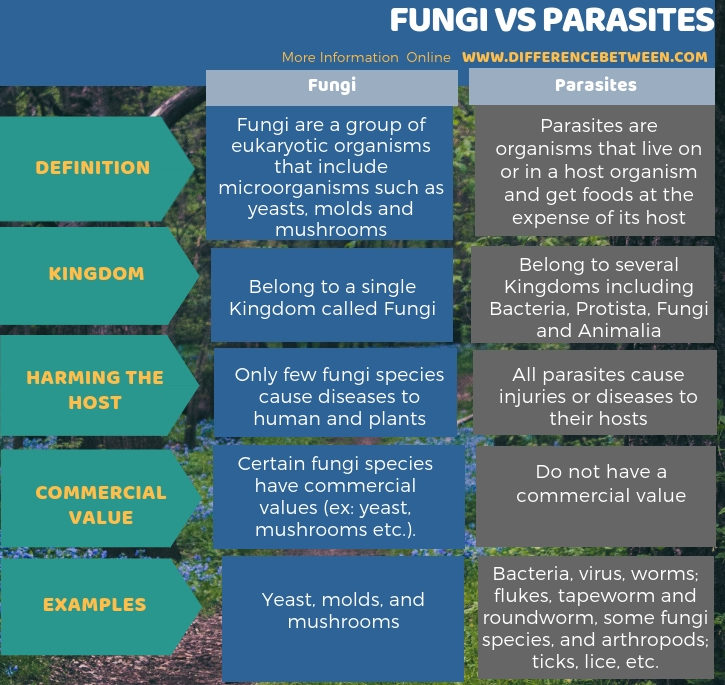The key difference between fungi and parasites is that fungi are a group of eukaryotic saprotrophic organisms including yeasts, molds and mushrooms while parasites are a group of organisms that live on or inside another organism obtaining nutrients.
Both fungi and parasites cause various diseases in humans. Not only in humans, but parasites cause diseases in other animals and plants as well. Parasites are the organisms that show a mode of life called parasitism. Parasitism is one of three types of symbiotic relationships that exists between two or more species living together. Certain fungi species, some insects, protozoan, and helminths are examples of parasites. In parasitism, the parasites live on or inside of another organism called host; parasitism gives benefits only to parasite while causing diseases to its host. Moreover, parasites cannot survive without their hosts.
CONTENTS
1. Overview and Key Difference
2. What are Fungi
3. What are Parasites
4. Similarities Between Fungi and Parasites
5. Side by Side Comparison – Fungi vs Parasites in Tabular Form
6. Summary
What are Fungi?
Fungi are eukaryotic saprotrophic organisms that belong to Kingdom Fungi. They live all over the planet. They are important organisms due to their ecological and economic roles. Most importantly, they contribute to the recycling of nutrients in the ecosystems by decomposition of dead organic materials. In addition, they also make symbiotic relationships with plants, which is essential for plant growth. Furthermore, fungi are also important as parasites and pathogens, which cause diseases to both animals and plants. For example, in humans, fungi cause diseases such as ringworm, athlete’s foot, etc, while, in plants, they cause rusts, smuts, stem rot, etc.

Figure 01: Fungi
Fungi are more chemically and genetically closer to animals than other organisms, and thus the treatment of fungal diseases are more difficult when compared to other human parasites. Moreover, some fungi species provide benefits to humans. For example, yeasts, Penicillium, and, mushrooms are important and essential in the bakery and fermentation industry as a food source and to make antibiotics, respectively. Generally, the fungal body appears as a thallus, which is of either a single cell or a thread-like structure called hyphae.
What are Parasites?
Parasite is an organism that lives in or on another different organism called host, and obtains nutrient and shelter from the host without destroying it. Parasitism is the form of symbiotic association they show. Parasitism allows the parasite to take benefit from the host while causing injury to hosts. This mode of life is one of the most common on the earth and it exists in all the major taxa, starting from small unicellular organisms to complex vertebrates. Parasites are eukaryotic, unicellular, or multicellular organisms. However, most of them are motile.

Figure 02: Parasite
Parasitology is the study of parasites. The basic characteristics of parasites are the presence of a simple to complex life cycle, often involving two hosts, presence of sexual and asexual reproduction, and performing all biological functions such as reproduction, digestion, respiration, and excretion.
Based on the morphology of organisms, there are two main classes of parasites; (a) protozoa, which includes all the unicellular organisms such as bacteria, virus etc., and (b) metazoan, which contains all the multicellular parasites such as parasitic worms; flukes, tapeworm and roundworm, some fungi species, and arthropods; ticks, lice, etc. Furthermore, there are two more categories of parasites depending on the place they live in their host. They are endoparasites and ectoparasites. Endoparasites live inside the body of their hosts, while ectoparasites live on the surface of the body of their hosts.

What are the Similarities Between Fungi and Parasites?
- Both fungi and parasites are eukaryotic organisms.
- Some fungi are parasites.
- Both fungi and parasites cause diseases to plants and animals including human.
What is the Difference Between Fungi and Parasites?
Fungi are a group of eukaryotic organisms such as yeasts, molds and mushrooms. On the other hand, parasites are a group of organisms which are in an association of another organism called the host. They live on or inside the host organisms obtaining nutrients from the host. This is the key difference between fungi and parasites. Fungi belong to the Kingdom fungi while parasites belong to several kingdoms including, bacteria, protista, fungi and animalia. This is also a difference between fungi and parasites.
The below infographic summarizes the difference between fungi and parasites.
Summary – Fungi vs Parasites
Fungi are a eukaryotic group of organisms that are yeasts, molds and mushrooms. They are mainly saprotrophic organisms. Some are parasites as well. On the other hand, parasites are another group of organisms that live on or inside the host organism deriving nutrients from the host. Parasites cause harm to their host. They are unable to live without the host organism. Some fungi are commercially important. But parasites are not commercially important. This is the summary of the difference between fungi and parasites.
Reference:
1. Clark, Mary Ann, et al. Biology 2e, OpenStax Biology 2nd Edition, 5 Mar. 2018, Available here.
2. “About Microbiology – Fungi.” Microbiology Online, Available here.
Image Courtesy:
1. “Fungi collage” By BorgQueen – Sources clockwise from top left: File:Amanita muscaria tyndrum.jpg, File:Scarlet elf cap cadnant dingle.jpg, File:Mouldy bread alt.jpg, File:Spizellomycete.jpg, File:Aspergillus.jpg (CC BY-SA 2.5) via Commons Wikimedia
2. “Parasite140080-fig3 Gastrointestinal parasites in seven primates of the Taï National Park – Helminths” By Roland Yao Wa Kouassi, Scott William McGraw, Patrick Kouassi Yao, Ahmed Abou-Bacar, Julie Brunet, Bernard Pesson, Bassirou Bonfoh, Eliezer Kouakou N’goran and Ermanno Candolfi – Kouassi RYW, McGraw SW, Yao PK, Abou-Bacar A, Brunet J, Pesson B, Bonfoh B, N’goran EK & Candolfi E: Diversity and prevalence of gastrointestinal parasites in seven non-human primates of the Taï National Park, Côte d’Ivoire. Parasite, 2015, 22, 1.doi:10.1051/parasite/2015001 (CC BY 4.0) via Commons Wikimedia
ncG1vNJzZmivp6x7pbXFn5yrnZ6YsqOx07CcnqZemLyue8OinZ%2Bdopq7pLGMm5ytr5Wau26y1KeeomWRo7FuvMCrmKyhpJrAcA%3D%3D